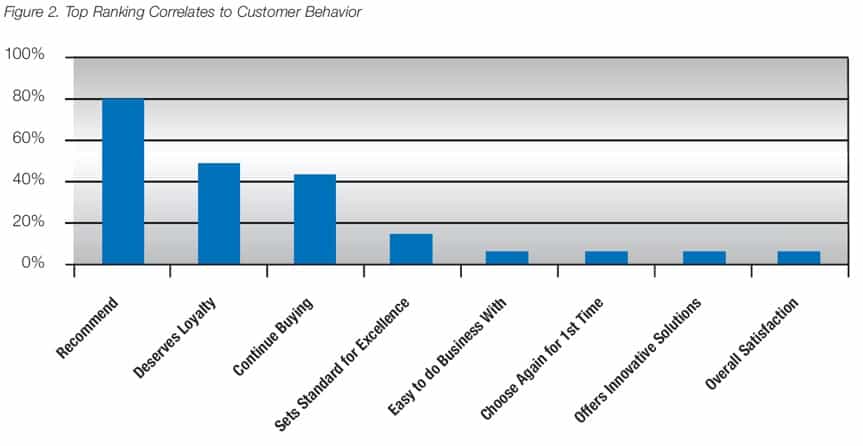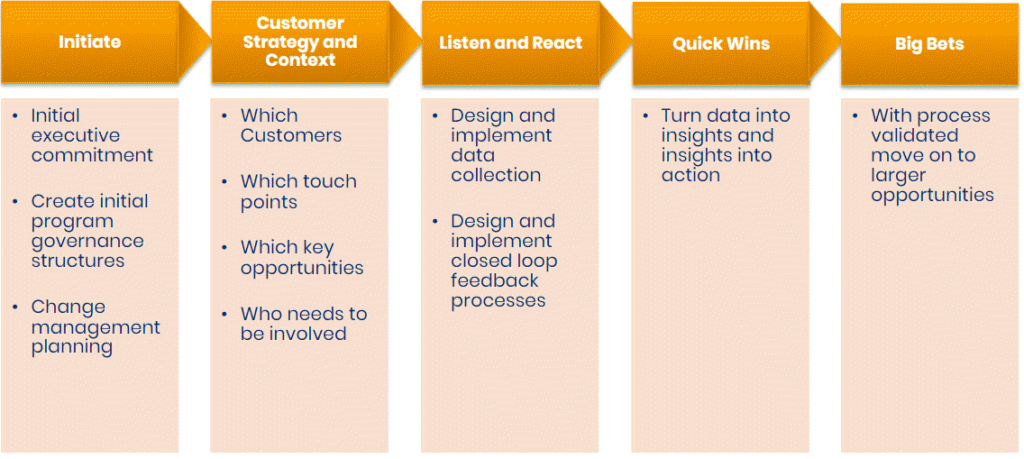OPEN MENUCLOSE MENU
- Services
-
-
B2B Customer Experience
-
B2B Marketing
-
-
- Resources
- About Us
- Contact Us
In this introduction to NPS we look at what it is and how you can use it to improve your business.
Net Promoter Score, or NPS®, is a customer survey question and analysis approach used by companies, large and small, to measure customer experience and predict customer loyalty.
While there are many reasons why NPS is important, it’s main benefit is that a company’s Net Promoter Score versus its competitors is a predictor of future business revenue growth.
NPS is often used as a key metric in Voice of the Customer programs.
To determine NPS® the following question is added to an organisation’s customer feedback survey.
The response is scored on an 11 point scale from Very Unlikely (0) to Very Likely (10).

Once the data is collected, Net Promoter Score is calculated by subtracting the percentage of 0-6 responses (Detractors), from the percentage of 9 and 10 responses (Promoters) to the “Would Recommend” question in your survey. The 7 and 8 responses (Neutrals) are ignored.
The overall score is then between -100 and +100
So, in NPS parlance:
And, NPS = Percentage of Promoters – Percentage of Detractors
Here is the NPS calculation in a formula:

Calculating NPS in Excel or Google Sheets is very simple and typically uses the COUNTIF function.
Because the approach is seemingly so simply, just one question, many organisations that start to use it have just add the “would recommend” question to their existing surveys believing this is all that is needed. This is a mistake and does not work.
When you implement Net Promoter you need to collect not just the “would recommend” rating but also the reasons for the rating.
You can do this in several ways;
However, you do it, the why part of the feedback is essential to your success.
The primary reason that NPS is important is that it is a easy to use predictor of customer loyalty.
For this reason Customer Success Managers will often use it as one of their KPIs.
And companies who use NPS to focus their business improvement process see returns over and above the average.
There are many case studies to demonstrate these links.
There are two ways to collect NPS data.
The purpose of a Relationship Net Promoter Score survey is to identify how your business compares with its competitors with respect to overall customer loyalty and the drivers of overall customer loyalty. It is a way to benchmark your company against its competitors.
Relationship NPS surveys are performed on a regular basis, say every 6 or 12 months. They measure your organisation’s overall score.
The purpose of a Transactional Net Promoter Score survey is to measure the NPS of each customer transaction and gather information about what customers liked and disliked during that interaction. This data can then be used to make improvements to the touchpoints in the customer journey and ultimately improve the overall NPS for both the transaction and the relationship with the customer.
Transactional surveys occur after a customer has been through an interaction with your business. It could be a sale, business process or customer service interaction.
The approach was first presented in a Harvard Business Review article titled: The One Number You Need to Grow in December 2003. The author of the article, Fred Reichheld, was well known in the customer loyalty industry and had performed some unique research.
He wanted to find out if one question could be used to predict a customer’s loyalty. So he asked tens of thousands of customers, lots of different questions, and then cross referenced their loyalty using actual purchasing data.
By testing different approaches, empirically, he discovered that NPS was most often the best indicator of customer loyalty.
Until that time organisations had been using “customer satisfaction” or complex calculations of several different variables to try to predict loyalty. In general customer satisfaction was found to be a quite poor predictor of customer loyalty. The other approach, complex calculations, was found to be accurate but difficult to implement and understand.
In identifying the simple approach, Reichheld had identified an easy to use metric that actually predicted customer loyalty.

Employee Net Promoter Score®, or eNPS, is seen increasingly often in company reports because it is seen as a way to:
It uses the standard NPS question, just tweaked a little to be focused on the organisation’s employee not it’s products and services.
While the formula to calculate NPS is simple, operationalising it in your business is much more complex. You need to consider:
Market research style survey tools, SurveyMonkey, et. al., are great for one-off surveys but lack the features needed operationalise NPS and drive business success.
A dedicated NPS software platform is a better choice.
If you’ve ever done a statistics course (at any level) you will have heard of sampling and confidence intervals. These terms help you to understand how closely the responses you receive, match the overall population.
Unfortunately, because NPS is a net score (remember, Promoters – Detractors) the calculations are a bit different to those we do on other survey data.
Those calculations are not difficult but the concepts need a little explaining. Grab one of the resources to the side for a detailed explanation or download the spreadsheet which has the calculations already done for you.
It’s common for companies to wonder how good their score is.
In practice this is a very difficult question to answer because so many factors can affect the score.
So external benchmarks can be difficult to find and apply to your specific business.
On the other hand internal benchmarks are very effective. In this case a good Net Promoter Score is one that is better than you had last quarter, month, year.
“Good” is any score that is continuously improving.
Just like any system, there are proponents and detractors for the use of the score. As a high profile system it has been researched substantially and much of the work published.
There are only two NPS alternatives that are in common use as of 2022.
Launched in the 2010 Harvard Business Review article “Stop trying to delight your customers”, Customer Effort Score (CES) is less popular than NPS and has it’s fair share of criticism.

Customer Satisfaction has been used in customer feedback surveys for decades. The question is worded thus:

Successful NPS implementation is more than adding a new question to your existing customer feedback survey. There are 5 stages to properly launch it in a business.

Confirm senior management buy in and create the company structures that you need to drive change. You will also need to consider the change management.
Analyse your customer journey to design your data collection process:
Listen: design your data collection survey and start collecting data.
Implement some small, quick wins using the data you have collected.
With the process validated, and proof that it works, you can move on to larger opportunities.